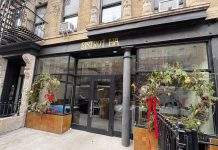
In the Post on Sunday, there was a piece from Steve Cuozzo that carried the headline, “The world’s hottest shopping city is becoming a ghost town.” He noted that major commercial corridors throughout the city are littered with vacant storefronts, and challenged the conventional wisdom from the real estate industry that the current retail slump is only temporary. “Bricks-and-mortar retail is shrinking so swiftly and on such a wide scale,” Cuozzo wrote, “it’s going to require big changes in how we plan our new buildings and our cities — although nobody wants to admit it.”
On the Lower East Side, as in much of the city, commercial blocks are filled with rental signs. The photos posted above were all taken during a short stroll down Clinton Street yesterday afternoon. These aren’t even all of the empty storefronts on the stretch between Delancey Street and East Houston Street — only a sampling. Just this past week, another retailer, Scumbags & Superstars, called it quits.
We’re all familiar with the forces battering both independent retail and large corporate stores. The Post points out that online shopping now accounts for more than 9% of all national sales. Then there are rising rents, and spiraling property taxes, which are passed on to beleaguered commercial tenants. In this neighborhood, there’s another factor: low foot traffic during daytime hours.
In a followup on Monday, Cuozzo zeroed in on another piece of the retail puzzle: the many new mega-projects under construction throughout New York. “Some 1.2 million square feet of newly minted retail space,” he reported, “are coming to the Manhattan leasing market at three major new developments — Hudson Yards, Manhattan West and Essex Crossing — even as vacant stores blight almost every part of Manhattan.” According to the story, developers are relatively unconcerned about having to lease so much new retail space.

Since Essex Crossing was mentioned, let’s take a look at how leasing has gone in the huge Lower East Side project.
The mixed-use (residential, commercial, community) complex at the foot of the Williamsburg Bridge includes 400,000 square feet of retail across nine development sites. Many of the anchor tenants have been under contract for months, if not years. They include: Regal Cinemas (65,000 sf), Trader Joe’s (30,000 sf), Target (22,500 sf) and Splitsville Lanes (17,000 square feet). Then there’s an expanded Essex Street Market (30,000 sf), which factored into the project from the very beginning. Taken together, more than 165,000 square feet of retail is already accounted for.
On top of these spaces, Essex Crossing includes the Market Line, a 120,000 square foot underground shopping pavilion. The first of three sections of that facility will open later this year with about 70 small vendors. Only a few of them have been publicly announced.
But assuming the team at Delancey Street Associates (the development consortium) fills out the Market Line, they will only have another 100,000 square feet of retail left to lease. Essex Crossing isn’t scheduled for completion until the year 2024.
The bigger question on the Lower East Side is what impact all of the new retail will have on existing small businesses and commercial spaces. If Essex Crossing draws a lot of new shoppers to the neighborhood, all retailers could benefit. But what if the project doesn’t become a shopping magnet? What if the big corporate stores such as Target and Trader Joe’s simply pull customers away from smaller merchants? We’re not going to have answers to these questions until Essex Crossing is open for business in a few months. Some neighborhood leaders are hopeful that other aspects of the project will help lift the fortunes of all businesses. At the top of the list: 350,000 square feet of office space spread across two buildings on Delancey Street. More office workers would mean more daytime street activity and, potentially, more customers.
On Sunday, Cuozzo concluded by arguing that it’s time for the city to rein in retail in new buildings:
We can still avoid becoming a retail ghost town like many of the country’s malls. But to increase demand for our dark storefronts, the city must roll back zoning rules in some neighborhoods that require even more retail in new buildings whether there’s demand for them or not. We should discourage the inclusion of acres of retail in giant new complexes that only add to the glut. Otherwise, the whole town will look like Broadway in the ’50s — a corridor of salad bars and dark windows.










